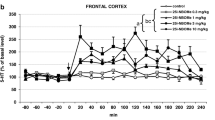Abstract
Bromocriptine (BRC), a dopamine D-2 receptor agonist, physostigmine, an anticholinesterase agent and pilocarpine, a muscarinic cholinergic receptor agonist, produced yawning in rats, with the most effective doses being 2.5 mg/kg, 0.2 mg/kg and 4 mg/kg, respectively. BRC-induced yawning was inhibited by high doses of SK&F38393 (5 and 10 mg/kg), a selective D-1 receptor agonist. BRC or SK&F38393 alone did not induced stereotyped behaviors. However, when BRC was administered after SK&F38393 (5.0 and 10 mg/kg), stereotyped behaviors occurred; i.e., mainly sniffing at 2.5 and 5.0 mg/kg BRC, and mainly licking and biting 10 and 20 mg/kg BRC. A high dose of apomorphine (4 mg/kg IP) completely inhibited physostigmine-induced yawning (physostigmine yawning) but did not affect pilocarpine-induced yawning (pilocarpine yawning). BRC (2.5–20 mg/kg) increased physostigmine yawning in an additive fashion. Pilocarpine yawning was completely blocked by either low or high doses of BRC. The inhibitory effect of BRC on pilocarpine yawning was reversed by sulpiride (20 mg/kg). α-Methyl-p-tyrosine (α-MPT; 100 and 200 mg/kg) did not affect physostigmine yawning but diminished pilocarpine yawning. Furthermore, physostigmine (0.2 mg/kg) inhibited apomorphine (4.0 mg/kg)-induced hyperlocomotion and sniffing but not licking and biting, whereas pilocarpine (4.0 mg/kg) had the opposite effect. These results suggest that activation of postsynaptic dopamine receptors (primarily D-1 receptors) may inhibit cholinergic neurons activated by cholinesterase inhibition, i.e., endogenous acetylcholine, and that the postsynaptic sensitivity of cholinergic neurons to a direct acetylcholine agonist (muscarinic M-1 receptor agonist) may be reduced by stimulation of presynaptic dopamine receptors (D-2 receptor) and/or inhibition of dopamine synthesis.
Similar content being viewed by others
References
Closse A, Frick W, Markstein R, Maurer R, Nordmann R (1985) [3H]205–501, a non-catechol dopaminergic agonist, labels selectively and with high affinity dopamine D-2 receptors. J Neural Transm 62:231–248
Costall B, Domeney AM, Naylor RJ (1983) Stimulation of rat spontaneous locomotion by low doses of haloperidol and (-1)-sulpiride: Importance of animal selection and measurement technique. Eur J Pharmacol 90:307–314
Dubuc I, Protais P, Colboc O, Costentin J (1982) Antagonism of the apomorphine-induced yawning by “a typical” neuroleptics. Neuropharmacology 21:1203–1206
Goldstein M, Lew JY, Hata F, Lieberman A (1978) Binding interactions of ergot alkaloids with monoaminergic receptors in the brain. Gerontologie [Suppl 1] 24:76–85
Hjorth S, Carlsson A, Wikstrom H, Lindberg P, Sanchez D, Haccksell U, Arvidsson L-E, Svensson U, Nilsson JLC (1981) 3-PPP, a new centrally acting DA-receptor agonist with selectivity for autoreceptors. Life Sci 28:1225–1238
Protais P, Dubuc I, Contentin J (1983) Pharmacological characteristics of dopamine receptors involved in the dual effect of dopamine agonists on yawning behavior in rats. Eur J Pharmacol 94:271–278
Robinson SE, Cheney DL, Moroni F, Costa E (1978) Acetylcholine turnover in specific brain areas of rats injected with various antidepressants. In: Garrattini S (ed) Depressive disorder. Schattauer, Stuttgart, p 129
Robinson SE, Malthe-Sørenssen D, Wood PL, Comissiong J (1979) Dopaminergic control of the septal-hippocampal cholinergic pathway. J Pharmacol Exp Ther 208:476–479
Spano PF, Trabucchi M (1978) Interaction of ergot alkaloids with dopaminergic receptors in rat striatum and nucleus accumbens. Gerontology [Suppl 1] 24:106–114
Urbá-Holmgren R, Gonzalez RM, Holmgren B (1977) Is yawning a cholinergic responses? Nature 267:261–262
Ushijima I, Mizuki Y, Imaizumi J, Yamada Y, Noda Y (1985) Characteristics of yawning behavior induced by apomorphine, physostigmine and pilocarpine. Arch Int Pharmacodyn 273:196–201
Ushijima I, Mizuki Y, Soeda K, Kishimoto O, Hara T, Yamada M (1987) Effect of age on behavioral responses to dopamine agonists in the rat. Eur J Pharmacol 138:101–106
Ushijima I, Mizuki Y, Yamada M (1988) The mode of action of bromocriptine following pretreatment with reserpine and α-methyl-p-tyrosine in rats. Psychopharmacology 95:29–33
Wood PL, Cheney DL, Costa E (1979) Modulation of the turnover rate of hippocampal acetylcholine by neuropeptides: Possible site of action of α-melanocyte-stimulating hormone, adrenocorticotrophic hormone and somatostatin. J Pharmacol Exp Ther 209:97–103
Yamada K, Furukawa T (1980) Direct evidence for involvement of dopaminergic inhibition and cholinergic activation in yawning. Psychopharmacology 67:39–43
Yamada K, Furukawa T (1981) The yawning elicited by α-melanocyte-stimulating hormone involves serotonergic-dopaminergic-cholinergic neuron link in rats. Nawnyn-Schmiedeberg's Arch Pharmacol 316:155–160
Author information
Authors and Affiliations
Rights and permissions
About this article
Cite this article
Ushijima, I., Mizuki, Y. & Yamada, M. Multifocal sites of action involved in dopaminergic-cholinergic neuronal interactions in yawning. Psychopharmacology 95, 34–37 (1988). https://doi.org/10.1007/BF00212762
Received:
Revised:
Issue Date:
DOI: https://doi.org/10.1007/BF00212762




